#burgundian dress
Text
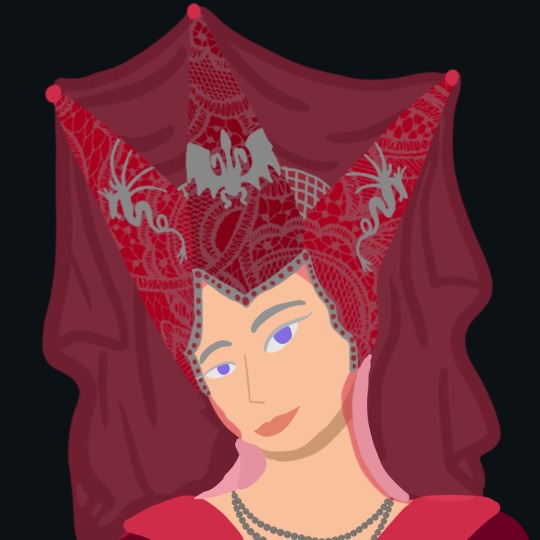
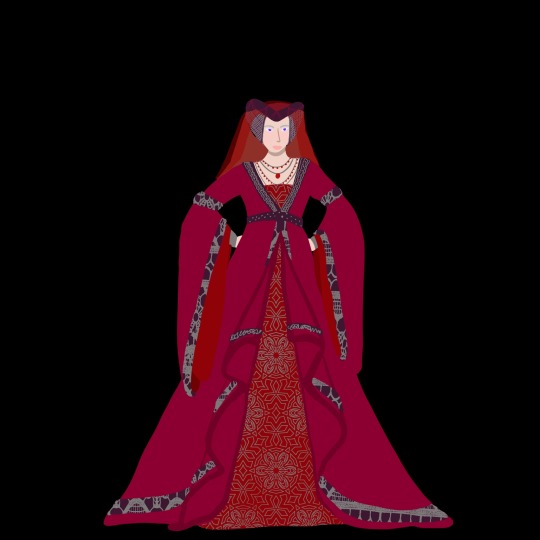
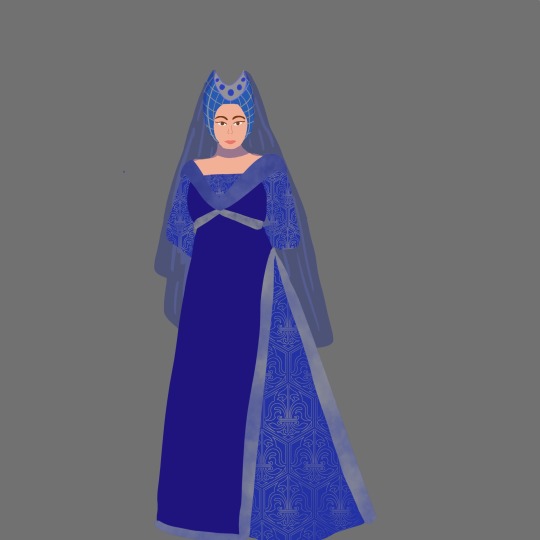



Queen Aemma Targaryen of the Seven Kingdoms and her ladies-in-waiting (Laeta Velaryon, Ronnalyn Arryn, Malia Hightower, Amara Martell)
Inspired by @15-lizards ‘s post about Aemma’s fashion influences during her time as queen. All of them wear some variations of a Burgundian gown and hennins, influenced by Aemma’s childhood in the Vale. They have their own personal spin on their outfits, also influenced by their own house histories. For example, Aemma has a triple horned hennin and a v-shaped hennin for the Targaryen dragons. Ronnalyn has a crescent shaped hennin for the moon door. Malia’s hennin is tall and the fabric on her dress resembles bricks because she’s a “high tower.” It’s not subtle but it’s not meant to be. Laeta has more fabric and accessories because she’s richer than the other ladies but it’s not garishly so because she’s not trying to outshine the queen.
#aemma targaryen#aemma arryn#queen aemma#house targaryen#house valeryon#house velaryon#house arryn#house hightower#house florent#house martell#a dance with dragons#dance of dragons#house of the dragon#HOTD#asoiaf#a song of ice and fire#game of thrones#pre asoiaf#asoiaf oc#Burgundian dress#Burgundian gown#medieval fashion#medieval dress#historical fashion#mine#hennin
48 notes
·
View notes
Note
I’ve found the stuff you’ve talked about as regards fashion in Thedas super interesting! On that note, if there any thoughts you have about things characters would wear or you think would be interesting for them to wear whether of your ocs or of canon characters, I’d be very interested.

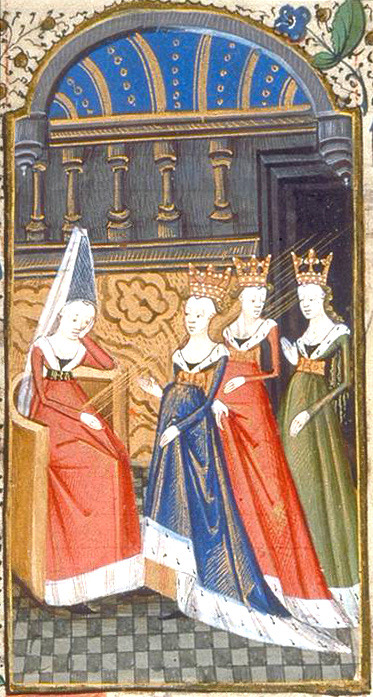

put those frenchwomen in hennins (the funky headdresses) right now. i also think they should dress more like this in general tbh like stop doing whatever you’re doing and put a burgundian dress on
#to be clear i dont actually know anything abt medieval fashion i am being an amateur enjoyer here#and these arent all hennins i dont think but it gets very confusing so im being generalising and wrong#anyway. i think isolde would wear a burgundian dress i quickly sketched it and turning her fit into something more like that works fairly#well i think#the fur makes her fit in a little but it’s still distinctly french
21 notes
·
View notes
Text
*pisses everyone off by writing/drawing the Northern Water Tribe as more Yup'ik and the Southern Water Tribe as more Inupiaq and refusing to acknowledge women's parkas with cinched in waists as canon*
#i'm sorry but i WILL NOT draw a hooded burgundian gown and call it an atigi#not in this life or the next#nor will you get pigeon-breasted tea dresses made of fur from me#eskimo on main#yes i know the yup'iit border the inupiat's southern territories. i do not care
72 notes
·
View notes
Text
Italy and France consistently show me they are the most fashionable ones in Europe no matter the era
#italian and french renaissance is just top tier#the houppelande dress? slays#the gamurra? the motherfuck queen of medieval dresses? fucking slays double#the honorary mention is the burgundian fashion
6 notes
·
View notes
Text


Alys Rivers, the Woods witch💚
The inspiration for her dress comes from the Burgundian fashion of the XV century. It was definitely fun working on this and I feel like in the future I will take some more inspiration from this era!
#alys rivers#gayle rankin#hotd#house of the dragon#house targaryen#hotd fanart#hotd art#my art#aemond targaryen
286 notes
·
View notes
Note
Just for fun: maybe a show of how both Aemma Arryn and Alicent Hightower would affect the court fashion by being from the Vale and Reach, respectably?
Oooh that sounds fun let’s do it!!
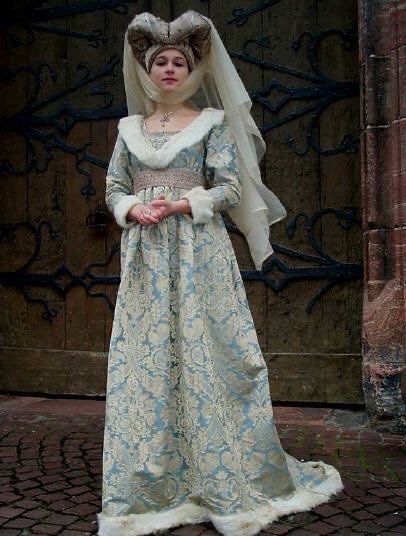

I believe in Burgundian dresses in the Vale supremacy. It just fits the vibe also fur!!! Very important no? Just overall a style that fits that elegant upper class vibe of the Eyrie before the dance, which Aemma grew up in. Big headdresses are the staple of every outfit, especially the hennin cone with a gauzy veil draped around. A very gentle, almost Virginia kind of fashion that Aemma grows up wearing and brings to Kings Landing when she becomes queen
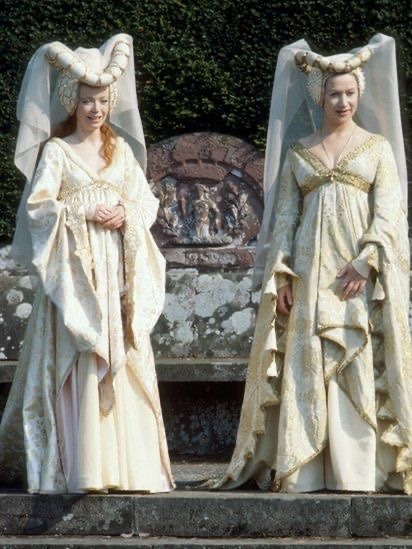
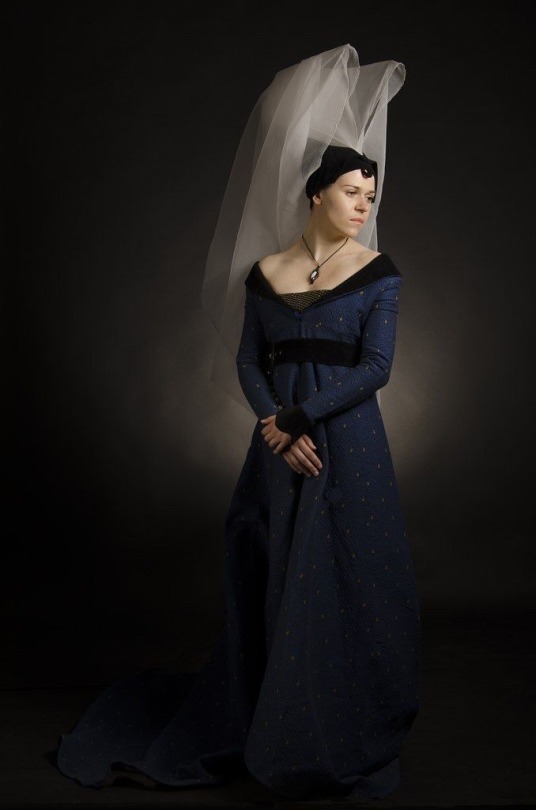
After a while in kings landing, this Eyrie fashion has adapted to the city. The basic cut of the gown is still the same, but seems to be a bit more complex and layered and sluttier. Ostentatious rich women take the idea of that elegant Eyrie fashion and just gild and glitz the shit out of it. OR a woman might downplay the gown and dress simply and just really heighten the look and size of the headdress, making it increasingly impractical (think the mid 1700s in France).


During Alicents early reign, she hasn’t garnered any influence or personal style yet and she’s still a young girl trying her best to get into the good graces of her old fart husband so she probably still resembles Aemma in her clothing. Modest and gentle without all of the grandiosity of the other women of kings landing, because of both the faith at Oldtown and her need to blend in as best she can. Eventually people start following in her footsteps, and more subdued and muted styles become popular, with a natural waist and bust coming back, as well as soft natural coloring
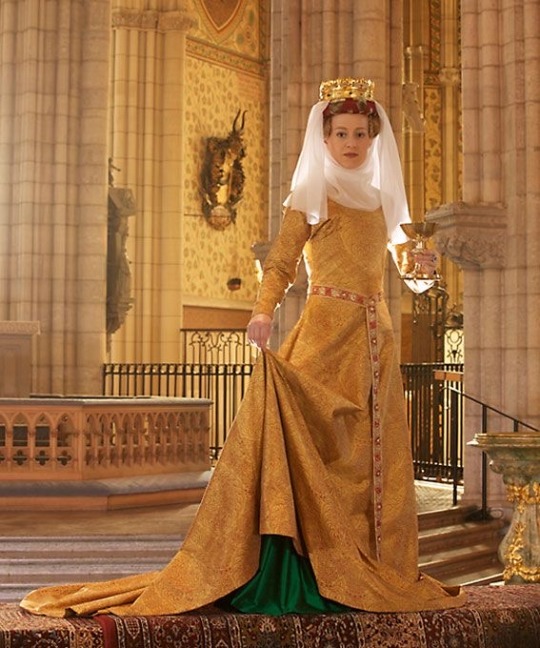

Once Alicent is firmly established, I think she starts to dress for piousness. Long sleeves that don’t billow out, skirts that cover everything and more, natural outline of the body, modest headdresses. And once the war begins this naturally starts to take hold throughout the city, as noblewomen go into mourning and also start to realize the excess they used to have cannot be afforded anymore.
#asoiaf#asoiaf hair and clothing#I know this kinda directly contradicts my fashion druring the dance ideas but#take it up with my lawyer#also yes I’m using show Alicent characterization here#you can also take that up with my lawyer
294 notes
·
View notes
Text
One thing I'll never forgive the got costuming design department is that Vale is peak medieval burgundian fashion coded (in my mind). I'm speaking fancy headdresses, head scarves, veiles! Fur trimmed dresses in bold colours and with dropping sleeves! Men in tights! Vale-wide fights about how short a gentleman's upper garment is allowed to be before... too much is exposed.
And instead we got weird flowy garments (they live on a mountain range, it's cold up there, babes) and Sansa's weird raven goth era that didn't commit hard enough
#asoiaf#got#sansa stark#the vale#asoiaf fashion#sorry for spelling and stuff I couldn't be bothered to look up the vocabulary#will probably regret that desicion later on
299 notes
·
View notes
Text

On July 3rd 1449 James II took formal control of his kingdom following his marriage to Marie of Guelders, niece of the Duke of Burgundy in Holyrood Abbey.
Marie, or Mary as she became known in Scotland had been earmarked to marry Charles, Count of Maine, but her father could not pay the dowry. Negotiations for a marriage to James II in July 1447 when a Burgundian envoy went to Scotland and were concluded in September 1448. Philip promised to pay Mary’s dowry, while Isabella paid for her trousseau. Philip the Good, Duke of Burgundy settled a dowry of 60,000 crowns on his great-niece and Mary’s dower (given to a wife for her support in the event that she should become widowed) of 10,000 crowns was secured on lands in Strathearn, Athole, Methven, and Linlithgow.
William Crichton, Lord Chancellor of Scotland was sent to Burgundy to escort her back and they landed at Leith on June 18, 1449. Marie was 15 and James 19 when the two wed on July 3rd and immediately after the marriage ceremony, Mary was dressed in purple robes and crowned Queen of Scots. Consort by Abbot Patrick.
A sumptuous banquet was given, while the Scottish king gave her several presents. The Queen during her marriage was granted several castles and the income from many lands from James, which made her independently wealthy. In May 1454, she was present at the siege of Blackness Castle and when it resulted in the victory of the king, he gave it to her as a gift. She made several donations to charity, such as when she founded a hospital just outside Edinburgh for the indigent; and to religion, such as when she benefited the Franciscan friars in Scotland. The couple had six children, the oldest James, became James III.
James II died when a cannon exploded at Roxburgh Castle on August 3rd, 1460, before his death he had ordered another castle be built for his wife who was left to oversee it’s construction as a memorial to him, Ravenscraig was still being built when Marie moved into east tower. She also founded Trinity College Kirk in Edinburgh’s Old Town in his memory, she herself died and was buried there in 1483, the old Kirk was demolished, amid protests in 1833 and Marie was interred at Holyrood Abbey.
19 notes
·
View notes
Text
So uhhh my headcanons on feminine clothing in the “main four” Westerosi regions in my mind, ie the four regions that are right next to each other with the majority of influence in the Seven Kingdoms and the most similar cultures. The Riverlands, Westerlands, Stormlands, and Reach. In my head they all wear various forms of clothing from roughly the late middle ages, with specific styles for each region


The Westerlands are a pretty basic Tudor shape. They’re all about ostentatious displays of wealth in every possible way, rich fabrics, rich jewels, time consuming constructions, etc. The flaunting of wealth extends even to things like wider sleeves that use up more fabric. In general, the idea is not just to show off, but also to sort of stand out against the landscape. With lots of flatlands, Westerland women prefer deeper, richer colors and textures. Plus it means not very much floral or nature motifs in fashion.


The Riverlands are similar to the Westerlands in silhouette as they are right next to each other, but are much more subdued when it comes to extravagant jewels. They’re a more down to earth culture, so narrower sleeves and modest necklines, more gloves and hats as you get further north. That being said, as they are practical people impracticality is their version of wealth flaunting - ie, clothing that is time consuming to make, costs a lot of fabric and material, and/or is difficult to wear and move in. Ruffs, even small ones, are a staple amongst all nobility. For their highest born ladies, especially on special occasions they’ll break out the French farthingale. And of course, the whackiest of shapes for headgear.
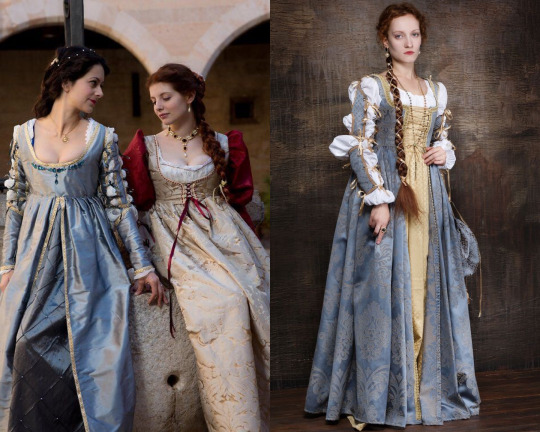

I envision that as you get further south in Westeros the clothing becomes less structured. The Reach is the epitome of the romanticized medieval period, where they believe in true knights and chivalry. Their clothes are all designed with a romantic aim in mind. The silhouette allows for a flattering structure no matter your body type, and the skirts get to flow freely around you. The Reach style is the epitome of fashion in Westeros, and it’s influences are being seen all over - even Cersei Lannister as queen occasionally veers away from her staunch loyalty to her homeland’s styles for the sake of staying fashionable and attractive. The Reach is a massive chunk of Westeros, so the border parts of the reach do bear similarities with styles from other regions. Go north and you’ll see some Westerlands decor elements on Reach silhouettes, go towards the Stormlands and the fabrics get thicker and more durable, more similar to houppelandes.

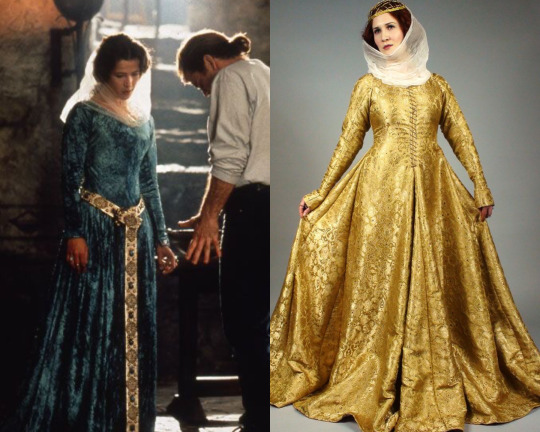
The Stormlands have been wearing the same styles for years and years, as they have less care for frivolities like fashion (so they say - they still very much like to dress wealthy). That’s only recently started to change, what with a Baratheon on the throne bringing an eye to their region for more than just their port trade. Less dress structure in the south, and a cage skirt like a farthingale is incredibly impractical in stormy weather. Instead, it’s a lot of layers of very heavy fabrics. Richer women show off with more and more expensive damasks and velvets, along with more fabric. Using more fabric than is necessary is the ultimate showing of wealth, and skirts being so long and heavy that the noblewomen have to actually carry them shows how little they have to work for that wealth. I think amongst younger people, Reach styles are starting to have an influence as they are right beside the Stormlands. Burgundian gowns have become all the rage, especially as you can add fur linings to it (both useful and showy in the windy Stormlands). In general more defined and higher waists are becoming much more commonly seen, especially once Renly married Margaery and his supporters in the Stormlands start to emulate her.
37 notes
·
View notes
Text
… Eleanor Cobham was a respectable lady who might expect to become a member of the household of a royal woman or member of the upper nobility, before being married and gaining a household of her own. Eleanor’s upbringing was likely to be typical of a woman of her class. She would not have had an exemplary education like Joan of Navarre did, but she does seem to have been taught to read in English, and she may even have learnt to write. Her education would have only been to a level that she would then be capable of running a knightly household and estate once married. The rest of her upbringing would have been focused on feminine values to help attract and keep her a husband, such as singing, dancing, music and needlework.
No known physical description of Eleanor exists, and only one contemporary picture of her survives. This is an illuminated miniature from 1431 of Eleanor with her future husband, Humphrey, Duke of Gloucester, from the Liber Benefactorum of St Albans by Thomas Walsingham. Eleanor and Humphrey were benefactors of the Abbey of St Albans, shown in Humphrey’s hand in the picture, but little of Eleanor’s real physical attributes can be garnered from the picture, it being a typically stylised miniature of the time. Eleanor is shown with a high forehead, the popular style, but her hair is hidden under a covering, so the colour is left a mystery. She is shown as slim and tall, but whether this mirrored her real stature cannot be known for certain. She is wearing a sumptuous red dress with a golden belt, a black head covering with a golden circlet, and a thick golden necklace, representing the wealth of her station as Duchess of Gloucester.
While there is no surviving physical description of Eleanor, it is reasonable to assume that she was an attractive woman. Jehan de Waurin, a Burgundian chronicler and contemporary of Eleanor, describes her as ‘a very noble lady of great descent … also she was beautiful and marvellously kind [pleasant]’. As she was later to attract the attention of a prince, it is likely that she was at least fairly attractive, and probably had sufficient wit and charm to go with it.
Gemma Hollman, "Royal Witches: Witchcraft and the Nobility in Fifteenth Century England"
21 notes
·
View notes
Note
hai ari whats ur dream fashion style? not like what you dress like now, but what u wish u could wear? :33
Well, 15th century armour of many varieties...
This is the early 15th century style -note the smooth, short breastplate and the relatively long fauld or 'skirt of plates' to protect the lower abdomen. This is the kind of armour that would have been worn by Jeanne d'arc, and indeed her English enemies.

The early 15th century is also where we start to see the dying out of cloth coverings for most soldiers, like these rather fetching fellows and their excellent tabard. There's a move towards bare metal as the 1400s progress.
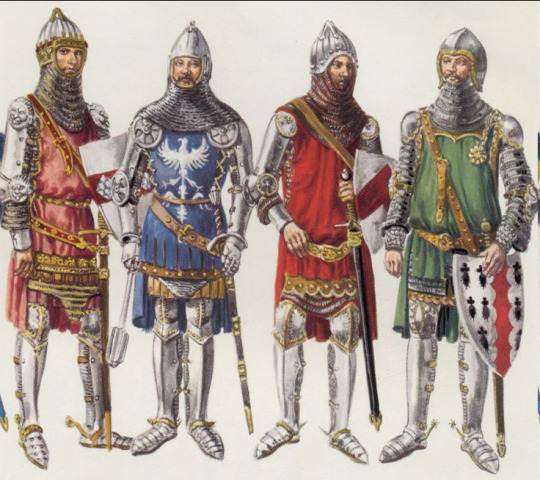
Further forward we see the Burgundian style come into its own, and I really do like their look. I do love me some brigandine, something like what the fellow in white is wearing.
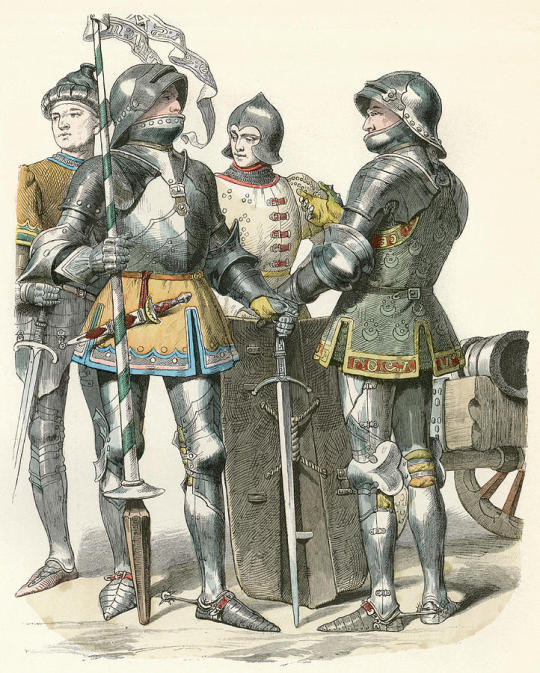
Something that also appears in Burgundy are various depictions of the armour people belived the great heroes of the past wore -this is fantasy armour in a time when plate armour was arguably at its peak importance, and it looks cool as fuck.

Following this, we have the pinnacle of the German Gothic style. And goddamn is that shit sexy.
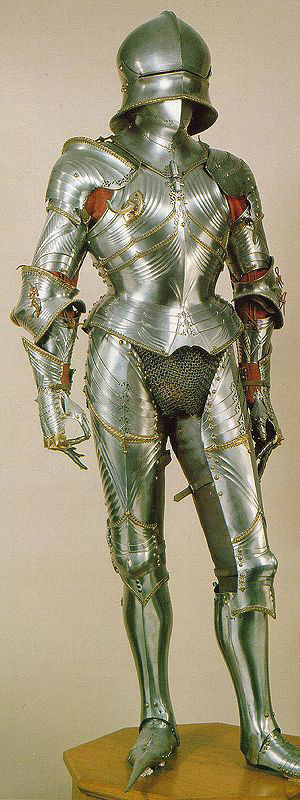
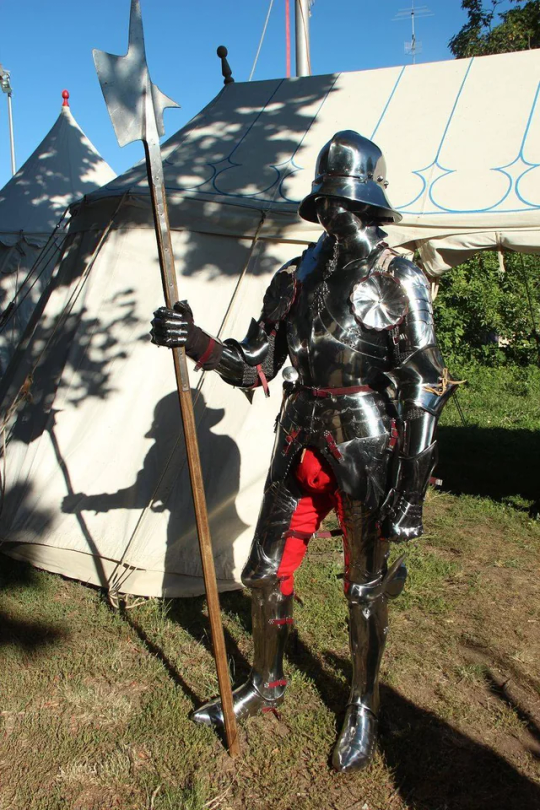
Special mention to brigandine again. That shit slaps So hard, it's almost as proctective as full solid plate (there's not much in it), it's more flexible and it looks SO GOOOOOD like look at this shit
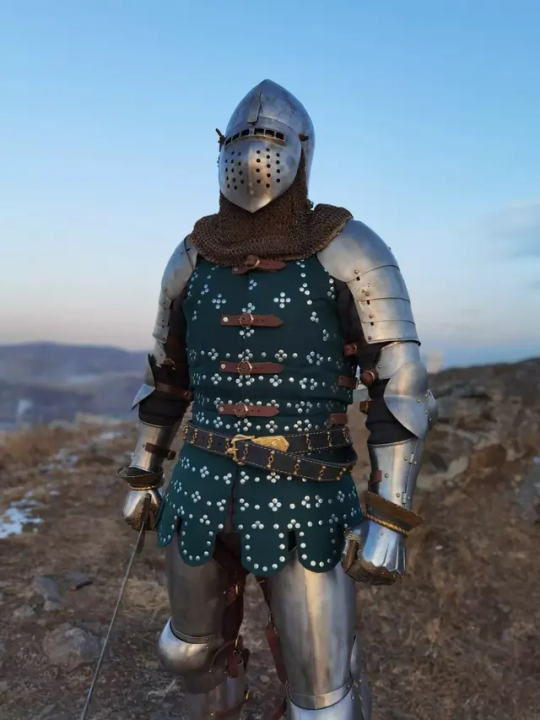
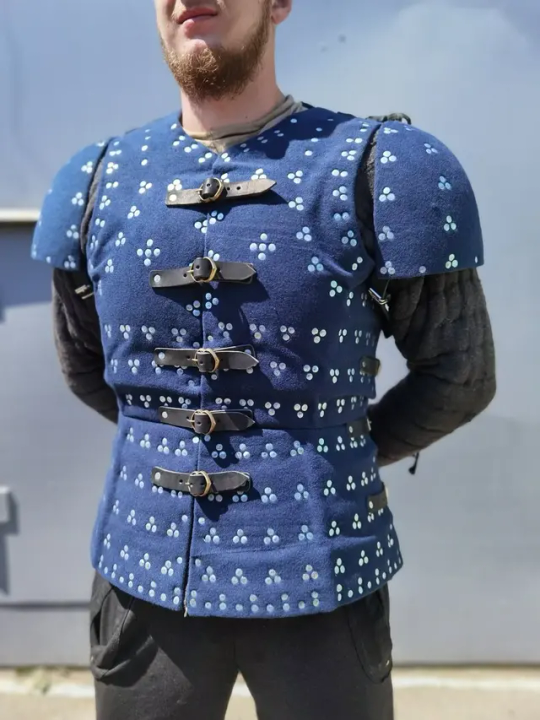
(this is a more fantastical design but it still holds up)
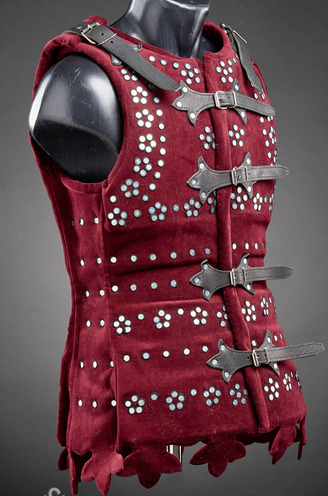
Plus, they can get SUUUUPER fancy too!


The second of these isn't a super high quality image but I've seen it in person and it is stunning. The fabric it uses is actually an off-cut from the late Queen Elizabeth II's sofa!
Plus, special mention to chinese brigandine armour, of which there are so many cool styles. this is a Ming dynasty example, and man I gotta learn more about chinese arms and armour it looks cool as shit

Aside from medieval armour, I do very much dig the sorta fantasy-piratical aesthetic. Tall boots, corsets, funky hats, big long flowing coats and frilly shirts... What's not to love!?
9 notes
·
View notes
Text
I love the idea of rival factions at the Royal court with distinct styles of dress and I think one with untapped potential is the Great Council’s decision to choose the next heir aka Rhaenys vs Viserys.
One of Rhaenys’s greatest strengths is that she comes from three different houses so she would always represent House Targaryen, House Baratheon, and House Velaryon with her clothes. I think her primary colors would be red and gold in a Velaryon style of dress. Red for her dragon (Meleys the Red Queen) and for the Targaryens, and gold for the Baratheons and to show off her wealth. I think she would wear House Velaryon’s colors if she did not she need to assert herself as the Targaryen heir. Wearing a Velaryon styled gown she uses more subtle ways to align herself with the Velaryons. (See the hairstyle drawings for a better crown.)

Additionally, while she is feminine, she knows that Westeros is hesitant to elect a female ruler so she tone down her femininity. Therefore, no low cut dresses and nothing formfitting and nothing too colorful. I see Velaryon style dresses being based on Old Valyria (aka the Byzantine Empire) so a lot of shapeless dresses with a single stripe down the front and a v collar so this works in her favor. Sometimes she would layer these dresses with robes or long sleeves as well. This choice is also encouraged because she would not want to remind Jaehaerys and Alysanne about their relationship to their daughters. She emulates Jahaerys by wearing heavy fabrics, dark colors, dragon scale embroidery, and heavy jewelry like livery collars and crowns. Additionally, Rhaenys would definitely take hunting and dragon riding as an opportunity to network so she would have a whole wardrobe for outdoor activities. This wardrobe would be largely earthy tones to make herself seem more approachable to her hunting party. Again, nothing form fitting so she would wear bloomer style pants or have balloon sleeves. She takes out her copper armor during more serious or more formal occasions.
However, she wouldn’t want to be too masculine because Westeros is not ready for that either. She would wear take fashion cues from Alysanne and wear surcoats, braids, and flowing sleeves in the shape of dragon wings. Inspired by her mother, Rhaenys would wear flared dresses, gable hoods, bejeweled hair bands, and sarafan style sleeves. She would also have elaborate embroidery, statement necklines, a mantle- a long vest or cloak-, prints, and beading on her dresses as well since it’s Velyron fashion. Additionally, Rhaenys would wear elaborate and tall hairstyles with statement hair accessories. Most of these would have metals and gems collected from Corlys’s travels. Corlys would even commission a crown similar to the iron throne and Jae’s crown for her to wear on special occasions.



Rhaenys would always have an updo with a statement piece similar to a crown. Maybe she would wear her hair in braids with pins and rings adorning it for an added flare. Pearls would certainly be her main accessories but use gems from Corlys’s travels to adorn her headwear as well. I think hair nets like snoods and cauls would be popular on Driftmark since they resemble fishnets so she would wear them often as well. Also, since she’s under more scrutiny than others, she would make sure her hair is something that wouldn’t be easily disheveled. This is where her mother’s Stormland roots would come into play with tight braids and gable hoods.

Viserys’s strength is that he is a male heir with Targaryen features however I think he’s very clueless so he and Aemma would -play it safe and take their style inspiration from Jaehaerys and Alysanne. For Aemma, this would mean a similar color palettes, similar hairstyles, silver accents, and clothes designed form the same tailor. However, Aemma would put her own personal touch on that. For example, Aemma would wear Houppelande or Burgundian style gowns because a Vale fashion. I also imagine these would have lower necklines, and more lace details than Alysanne or Rhaenys as a way to appear more feminine. She would also wear soft colors and soft fabrics to appear more approachable to other members at court. Additionally, unlike Rhaenys, her jewelry would be sourced from across Westeros to give her a home land advantage. She would befriend ladies at the court by having favorite jewelers and tailors from each of their regions. After all, there is no better way to gain allies by showing you have personal interest in their homes.

For her hair, Aemma would almost always be wearing some sort of headpiece. A hennin and stickelchen for indoor occasions, designed by the same headdress designers as Alysanne, the Arryns, and the Hightowers. To support the Westeros economy of course. Also, if she’s feeling homesick, she has a hennin shaped like a crescent moon that represents the moon door in the Vale. She also has double or triple coned hennins to resemble dragon horns. If Viserys makes some sort of fauxpaus, she would wear a ridiculous headpiece so people would have something else to talk about. On other occasions, she would wear veils, hair nets, and metal headpieces similar to Old Valyrian styles. If her hair is ever visible, I think she would wear it either wear with ribbons, pins, or in bound braids like Alysanne.

Also building on her relationship with Viserys, she would wear things that would appeal to his interests. Since he is so interested in the histories, she wears a lot of Old Valyrian inspired clothing. Her sleeves are inspired by Valyrian architectures such as battlements. Her hennins sometimes resemble spires. Her bodice can resemble ceiling beams and neckline can resemble buttresses. If she’s wearing a dress with multiple colors, it would be inspired by stained glass. The stained glass could also resemble the Sept which appeals to followers of the Faith people as well. I imagine Viserys would’ve written her a poem or song about a long extinct flower from Valyria and how he would grow fields of them for her if he could. Which might showcase their relationship- he’s all about hypothetical gestures that appeal to his interests. But, it would work on her while she’s young so some of her dresses are the same color as that extinct flower.



#rhaenys targaryen#rhaenys the queen who never was#aemma arryn#aemma targaryen#asoiaf hair and clothing#valyrianscrolls#rhaenys velaryon#rhaenys x corlys#queen aemma#house of the dragon#hotd#viserys targaryen#corlys velaryon#corlys valeryon#fuck viserys#game of thrones#got#costumes#hotd fanart#asoiaf fanart#my art#mine
76 notes
·
View notes
Text
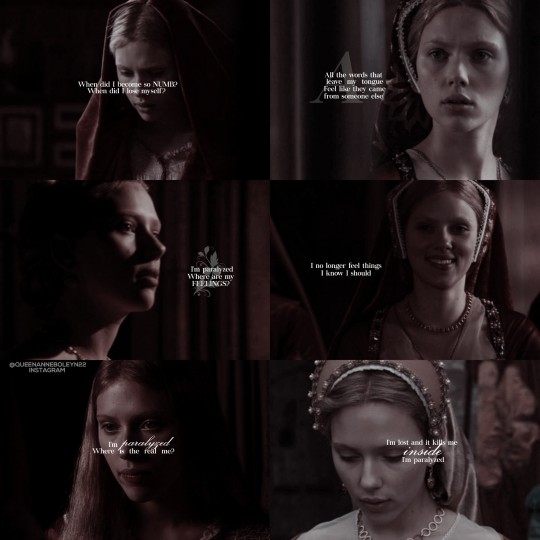
"It was probably William Cornish who produced the pageant and played the role of Ardent Desire: Hall makes it very clear that it was not the King. This was Cornish’s last major pageant: he died in 1523, and was succeeded as deviser of court revels by John Rightwise, who continued in the same tradition. Rightwise, a clever Latinist, succeeded William Lily that same year as High Master of St. Paul’s School. Mary Tudor, Duchess of Suffolk, led the dancers as Beauty; the Countess of Devon played the role of Honour; Mary Boleyn was Kindness; Jane Parker, the daughter of Lord Morley and shortly to be betrothed to Mary’s brother George Boleyn, was Constancy; and Anne Boleyn, Mary’s younger sister, recently recalled from the French court because of the deteriorating political situation, was Perseverence. Anne Boleyn was just embarking on her spectacular but ultimately disastrous career, and this was her public debut at the English court. Born around 1501, she had spent her formative years first at the brilliant court of Margaret of Austria, then in the household of Mary Tudor during her brief reign as Queen of France, and later as a maid of honour to the pious Queen Claude. At the Burgundian and French courts, Anne had gained a fine education and learned every sophisticated accomplishment and on her return to England, her father—or possibly her sister’s influence—was able to secure her a place in Queen Katherine’s household. Anne stood out among the ladies at the English court because she was so French in her manners and style of dress, and therefore at the forefront of fashion. Anne was then about twenty-one, rather old to be unmarried. For two years now, her father had been negotiating to wed her to Sir James Butler, heir to the Earl of Ormonde, to settle a dispute over the Ormonde inheritance; but the matter was dropped for reasons that are not clear. Thanks not only to Sir Thomas Boleyn’s talents as a diplomat and courtier, but also no doubt to his daughter Mary’s occasional occupancy of the royal bed, the Boleyns were in the ascendant and becoming very influential." - Alison Weir, The king and his court.
#perioddramasource#perioddramacentral#perioddramaedit#mary boleyn#scarlett johansson#the other boleyn girl#theotherboleyngirledit#tobgedit#tobg#maryboleynedit#tudor england#tudorssource#tudorsource#tudorsedit#the tudors#historical women#history#historyedit#the other boleyn girl#boleyn#anne boleyn#henry viii#eric bana#lyrics#lyricsedit#alison weir#sjohanssonedit#16th century#english history#historical
57 notes
·
View notes
Note
Do you have specific fashions you attribute to/associate with a region or house in asoiaf?
I have to admit I'm not very consistent in my tumblr illustrations about this but ...
In general, my absolute preference for fashion in Westeros is 14th / 15th century Europe. If I had to decide, I would bring Houppelande back into fashion, I love it. Burgundian gowns too.
In a more reasoned way, I like to associate "Viking" fashion with the Ironborn for obvious cultural similarities. Another association that I like and maybe I should investigate more is that between the North and Kievan Rus'. For Dorne I love the Byzantine influence.
Another thing that I often let myself be influenced by in the taste of clothes is Italian art from the late Middle Ages to the early Renaissance. The Reach should be Florence and Braavos the Venice of the doges.
I don't have a too structured idea about it, I often keep elements that convince me and I ignore those that don't. Sometimes I use models that exist, but I make the characters wear them in an unconventional way or by choosing a decorative pattern that is not philologically correct. I often use fabric buttons, detachable sleeves, layered dresses, poulains, brooches, fur trims for example.
The thing that matters to me more than historical correctness is that the dress communicates something about the character. I like to try new ways to put sigils in the clothes.
I avoid references to Clapton like the plague because I don't agree with many of her choices and I want to get away from the imagery of the TV series. And I also try to avoid some clichés of the fantasy aesthetic because it is very easy to expire in the discounted version of Tolkien and I don't think it goes well with the mood of Asoiaf.
Having said that, I always accept input and advice regarding these things. Thanks for asking!
55 notes
·
View notes
Text
Drawn after the Quick
(ie Drawn from Life)

Colored woodcut print by an unknown English artist, generally dated to 1540-1550, possibly depicting Irish kerns who fought for King Henry VIII at the siege of Boulogne in 1544.
All 6 of the men wear a léine (linen tunic) with an ionar (short jacket) over it, and the 4 on the left have a brat (wool mantle). The men have their léinte rucked up to knee length and secured at the waist with a belt or cord. The léinte have the wide hanging sleeves that are typical of 16th c. Gaelic fashion. They also have a deep center-front opening, a feature which matches Burgundian courtier Laurent Vital's description of clothing he saw during his 1518 visit to Kinsale, Co. Cork:
"Generally the men, women, and young girls wear their shirts open to the waist. Most young women and girls have their chests naked to the waist." (translation taken from a lecture by Katherine Bond)
The ionair in this print are very similar in cut to the ionar of the Kilcommon bog outfit. The hat worn by the man in the red ionar is also similar to the hat of the Kilcommon outfit.
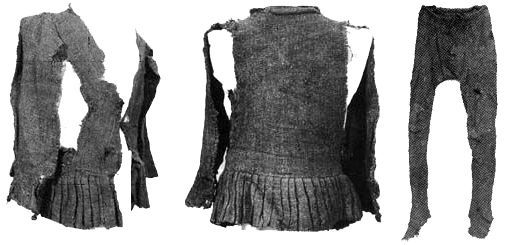

The floral scroll design seen on some of the ionair was a popular embroidery motif in England during the 16th-early 17th centuries. It also shows up in 16th c. Irish art like St. Brigid's shoe shrine.

4 of the ionair and all of the visible scabbards have fringe on them. Fringe was a popular embellishment in 16th c. Ireland. The use of fringe is mentioned in several 16th and early 17th c. descriptions of Irish clothing. Fringes made of wool and fringes made of silk were imported into Ireland during the 16th c.
In spite the claim that it was drawn from life, this print includes some stylistic exaggeration. The sword blades are depicted as having a bulbous tip, which actual Irish ring-pommel swords are not. Compare the swords in the print to this extant 16th c. sword from Tully Lough, Co. Roscommon in the NMI:

The print is currently in the collection of the Ashmolean Museum. https://collections.ashmolean.org/object/737327
Bibliography:
Arnold, Janet, Tiramani, J., & Levey, S. (2008). Patterns of Fashion 4. Macmillan, London.
Dunlevy, Mairead (1989). Dress in Ireland. B. T. Batsford LTD, London.
Flavin, Susan (2011). Consumption and Material Culture in Sixteenth-Century Ireland. PhD thesis.
McClintock, H. F. (1943). Old Irish and Highland Dress. Dundalgan Press, Dundalk.
Irish Ring Pommel Sword: New Insight into Use
National Museum of Ireland talk on St. Brigid's shoe shrine
Depicting and Describing Dress in Early Modern Ireland: lecture by Dr. Katherine Bond
#irish dress#gaelic ireland#irish history#irish mantle#bratanna#leine#ionar#fringe#embellishment#historical men's fashion#headwear#art#16th century#anecdotes and observations#dress history#bog finds#extant garments
22 notes
·
View notes
Text
Day 5: Isabeau of Bavaria
Isabeau of Bavaria (also spelled Isabelle or Elisabeth)
Born: c. 1370
Died: September 1435
Parents: Stephen III of Bavaria-Ingolstadt and Taddea Visconti of Milan.
Queen of France
Children: Isabella, Queen of England
Joan, Duchess of Brittany
Marie, Prioress of Poissy
Michelle, Duchess of Burgundy
Louis, Dauphin of Viennois
John, Dauphin of Viennois
Catherine, Queen of England
Charles VII of France
Isabeau was the only daughter of Duke Stephen III of Bavaria-Ingolstadt and Taddea Visconti of Milan and granddaughter of the Holy Roman Emperor Louis IV.
Isabeau was sent to France at the suggestion of her uncle to be considered a potential bride for Charles VI of France. The teenaer was prepared by her aunt, taught French customs and received french styled dresses. She went to France on the pretext of a pilgrimage. Her father refused for her to be examined in nude as it was customary at the time.
Upon arriving in France she impressed despite not speaking French or meeting the beauty standards of the time, it is likely she had Italian features like her mother.
Charles seemed smitten with her moving up the wedding.
The two were married in 1285. Isabeau was 15/16 at the time.
Charles lavished her with gifts and visited her at Château de Vincennes where she resided while he was on a military campaign against England.
The coronation of Isabeau took place on 23 August 1389 with a grand ceremony. The procession lasted the whole day.
Charles suffered from an illness that caused him moments of insanity. Often he asked for Isabeau to be removed as he did not recognise her. Isabeau was accused of abandoning him when she moved her residence to Hôtel Barbette. Charles was provided with a mistress by his advisors but in his moment of lucidity he exchanged letters and gifts with Isabeu. His illness continued until his death.
In the 1390s Isabeau was made the guardian of the Dauphin and the co-guardian of their children. She was responsible for the education and protection of their son. As Charles’s bouts of illness were more frequent Isabeau became the leader of the regency council.
As Isabeau sided with the king’s brother, Orléans, in the conflict between him and the burgundians rumors started to circulate that they were lovers. John the Fearless, the new Duke of Burgundy after his father’s death, raised an army and entered Paris. Isabeau and Orléans retreated to the fortified castle of Melun with the royal children, however John took possession of the Dauphin. The Duke of Berry, the Dauphin’s uncle, took control of the child. The fact that Charles was lucid for about a month also helped. Isabeau was tasked with mediating the dispute.
After Orléans' assassination, Isabeau’s concern was the safety of the Dauphin, going as far as to convince Charles to give his 13 year old son power in the absence of the queen. Isabeau created alliances and switched sides in order to protect the heir to the throne.
A double marriage was arranged in 1409 in order to diffuse tensions between burgundians and Orléanists in which Isabeau clearly defined the family hierarchy and her role.
Despite her best effort to stop a civil war, in 1411 the Armagnac–Burgundian Civil War broke out. The dauphin, aged 15, did not have the power or a capable army to defeat John the Fearless. Isabeau allied herself with Charles of Orléans in 1414 instead of allowing her son, aged 18, to lead. The Dauphin changed sides. While the civil war continued, France suffered a blow from England at Agincourt in 1415. The Dauphin died in December 1415 leaving his 17 year old brother and burgundian supporter as heir. In 1417 the new heir died, the new Dauphin aged 14 was Isabeau's last son. He was a sympathizer of the Armagnacs. At the time Isabeau was imprisoned by Armagnac but was freed by the Duke of Burgundy. From that moment she supported the burgundians Treaty of Troyes in 1420.
At first, Isabeau was the sole regent but yielded her position to John the Fearless in January 1418. Together they took control of Paris and slaughtered the Armagnacs. The Dauphin fled the city. John was assassinated in a plot by Dauphin Charles. After the assassination he was disinherited.
By 1419 Henry V of England occupied most of Normandy. In 1420, in the absence of an heir, Isabeau accompanied King Charles to sign the Treaty of Troyes. Due to his illness, Isabeau signed the treaty. Their daughter, Catherine, went on to marry Henry V as part of the agreement.
Isabeau died in late September 1435 in Paris.
The accounts on her appearance are contradictory, some describing her as small and brunette others as tall and blonde. She spoke with a heavy German accent that made her stand out at the French court. She was a skilled diplomat, navigating court politics with ease. She interfed on several occasions on matters of great importance and foreign affairs. She mediated conflicts and was trusted by the king. Like most of the Valois, Isabeau had a fondness for art, loved jewelry and commissioned particularly beautiful pieces. She left many personal possessions and properties, in life and in her will, toNotre Dame, St. Denis, and the convent in Poissy.
Isabeau was close with her children throughout their childhood and even after they were married. She kept them close to her, had them travel with her, bought them gifts and had her daughters educated.
#women in history#women history#french history#bavaria#queen of france#france#catherine of valois#1400s#15th century#medieval history#medieval
4 notes
·
View notes